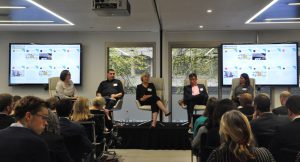The Future of (Employee) Engagement – Event write up
 This article is republished from a write up of an event I participated in at Instinctif Partners on 1st November 2018 in London. The event brought together HR and Engagement professionals, all with a view to exploring where the future might lie.
This article is republished from a write up of an event I participated in at Instinctif Partners on 1st November 2018 in London. The event brought together HR and Engagement professionals, all with a view to exploring where the future might lie.
“Leadership will remain at the heart of engagement” was a prediction made at a lively debate recently hosted by Instinctif Partners and the EEA in London. The Future of Engagement featured an expert panel which discussed the challenges we’ll be facing in the workplace of tomorrow. The event was attended by over 80 engagement professionals keen to hear the panel’s thoughts on future trends and technologies.
Our panel featured Futurist Matt O’Neill (MON); Internal Communications Director (former) for Rolls-Royce, Paul Diggins (PD); HR Director for Reach Plc, Julia Warren (JW); and Head of the People Communications and Engagement at EY EMEIA Financial Services, Naomi Rigby (NR).
Chair of the event, Instinctif’s Victoria Lewis-Stephens (VLS) challenged panellists with questions such as: What are the big trends you will prioritise in your organisation? How do you build a values-based business? And how will we engage a fragmented workforce?
What emerged from the debate was a contrast of future-proofing approaches: While we must keep up with technological progress, we must also continue to address our basic human needs.
PD explained that “Leadership will remain at the heart of engagement” with MON adding that “because machines are going to be better than humans at analysis,leaders in the future will be valued for the softer skills: their EQ for example.”
With this in mind, JW commented that: “We need to give leaders permission to create time to spend with their employees. They’re so preoccupied. Give them the critical case for spending time with people, because they aren’t machines, they do need that conversation – someone to ask them how they are. This sounds easy but it’s the most difficult thing to get them to do.”
NR explained that at EY they are already taking steps to address this: “A year ago we launched an initiative which focused on human behaviours and ensured that leaders set aside some space and time for deep reflection of their own and their team’s needs. It was initially tricky to change mindsets, but there is recognition that the ‘human element’ of leadership is going to be vital in attracting and retaining talent now and in the future.”
As the debate moved on to values-led organisations, PD pointed out that: “We all want to work for people and love what we do. One of the biggest shifts is that it’s more about whether you’re proud of your organisation and whether it’s making a difference in the world or for your customers; purpose is becoming central to engagement.”
While MON added: “We are seeing the growth of multi-stakeholder organisations. Completely new structures such as benefit corporations (B-Corps) are growing in popularity. I’m not sure the traditional A-class approach is completely sustainable in the new world.”
PD spoke about how digital channels have “morphed audiences into one” and the importance of managing your and the external messaging, as the story has to be the same. Leaders need to have transparent conversations and know where to go to remain informed. “It’s not about spin, it’s about making sure the leaders all understand the context as well as content.”
JW talked about her experience of following the trends of measuring engagement with pulse surveys. She felt the results didn’t tell the whole story and that human-to-human engagement needed to be revisited.
PD acknowledged that: “What gets measured, gets done.”
NR commented on the positive power of technology: “Technologies are impacting employee engagement for the better. We can now use it to get analysis on how people are feeling in the business. At EY, we have just introduced a new performance management approach – with more frequent conversations around our people’s careers.”
As part of that, the business has also introduced innovation around how their people interact with HR, she explained: “We have an HR chatbot which is AI-based and based on the questions people are asking, it’s able to provide real-time responses and gauge how people are feeling. Technology like this provides good sentiment analysis and is a great example of how tech is influencing people in a positive way and making our people’s experience better. However, it’s important we also recognise how change makes people – uncomfortable and uncertain… We need to emphasise what the opportunities are – to learn and relearn and transform yourself to be thrive in the future.
Building on this, MON explained that “a trend coming out of Silicon Valley is multigenerational coaching. Leaders looking to stay in touch have started hiring street smart 20-year-olds to coach them. D&I isn’t ‘optional’ going forward, especially given the rise and importance of neurodiversity.”
To summarise, MON had a positive message for all HR, engagement and communications people: “You are going to play such an important role in future organisations. Look towards modern Chinese corporations including Alibaba – HR is highly valued as they’re the defenders of the culture. As long as you continue to learn and push yourself up the value chain and let the machines do what they’re good at, you will thrive.”
